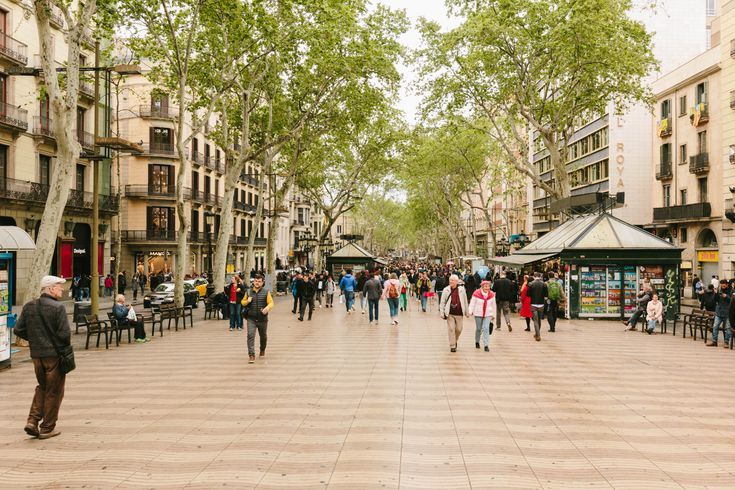The Ramblas: Barcelona’s most iconic street
The Ramblas: Barcelona’s most iconic street
Barcelona’s array of live music venues make it one of Europe’s top destinations to catch a live concert, whether it’s a classic musician, the latest and coolest bands, or internationally renowned festivals.
Visit La Sagrada Familia and discover one of the world’s great unfinished works of art, a huge church more than 130 years in the making, situated right in the heart of Barcelona.
Explore The Ramblas and discover the best of Barcelona, a city brimming with excellent street culture, colour, and a terrific atmosphere, as you guide your way along the beautiful 1.2km boulevard.
Spain’s Catalan region is the richest area in the country. Long industrial and commercial traditions focused around Barcelona, the region’s largest city, have fostered a rapidly developing trade fair culture and economy, with numerous internationally attended events.
From tourist hotspots to hidden gems, the districts in Barcelona are as varied as the city itself, offering travellers the chance to stay in a neighbourhood that allows them to choose their own experience of the city.
Picturesque Montjuic is much more than just a hill: it’s also a thriving city district that contains some of the best attractions in Barcelona, including museums and an amusement park, among other highlights.
Destination
Check in
Check out
- Invalid Range
Occupancy
room
1
Adults
Children
(2-11)
Babies
(0-1)
room
2
Adults
Children
(2-11)
Babies
(0-1)
room
3
Adults
Children
(2-11)
Babies
(0-1)
room
4
Adults
Children
(2-11)
Babies
(0-1)
room
5
Adults
Children
(2-11)
Babies
(0-1)
room
6
Adults
Children
(2-11)
Babies
(0-1)
room
7
Adults
Children
(2-11)
Babies
(0-1)
room
8
Adults
Children
(2-11)
Babies
(0-1)
room
9
Adults
Children
(2-11)
Babies
(0-1)
Promo Code
Promo Code
This day is not available for this offer.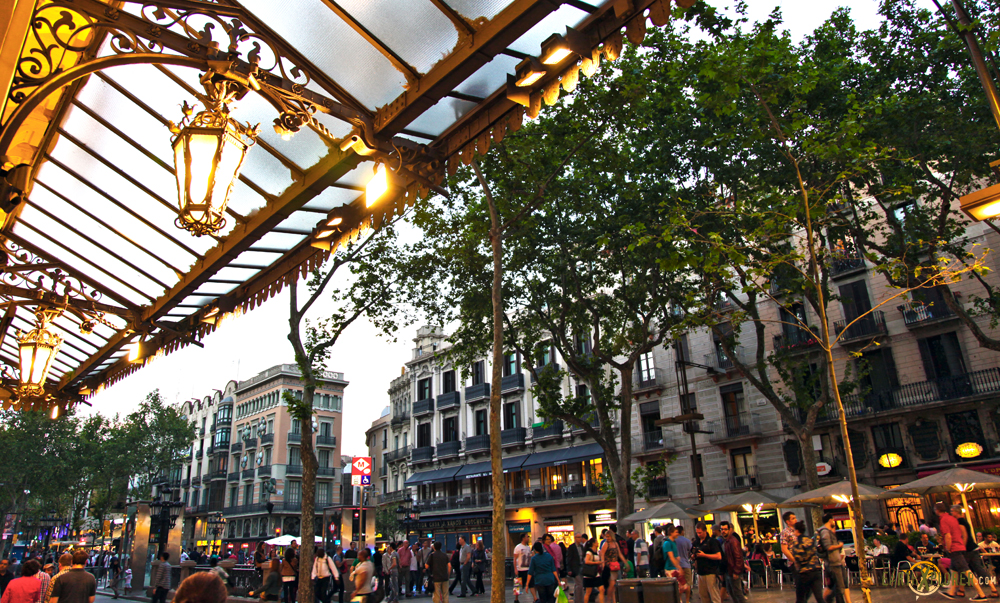
For reservations of more than 30 nights please contact our reservations team
on telephone
For reservations of 9 or more rooms please contact our reservations team
No matches found
We are unable to pinpoint your location. Activate the locations services on your device or type in a location.
The information given on the currency selected is merely informative. Charges will always be made in local currency
Join NH DISCOVERY and get 5% off for all your bookings
Loading results
Oops, something went wrong. Please contact the administrator
Exploring Las Ramblas de Barcelona Step by Step
Las Ramblas or La Rambla (from Arabic Ramla which means sand) is one of the most popular attractions in Barcelona.
It is a 1.2 km avenue, loved by both tourists and locals. Las Ramblas starts from Plaza de Catalunya and goes all the way to the Columbus statue.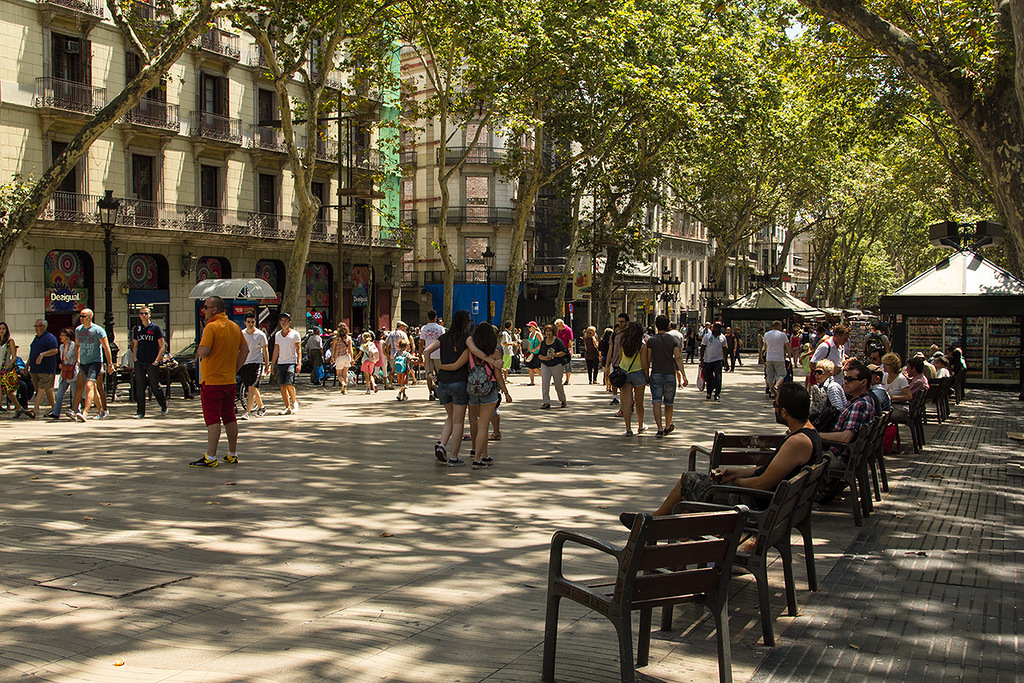
Strolling straight down Las Ramblas in Barrio Gotico you can look at the various shops or appreciate the variety of street performers, some of which have an spectacular act or an exciting outfit. There are also a number of newspaper kiosks and flower stands.
On each sides of Las Ramblas, there are many cafes and restaurants (including some of the best cheap tapas bars in Barcelona). It’s a great spot to eat or drink something while watching the activities going on the road.
Ask anybody who’s going to visit Barcelona where they’d like to stay, and the common reply is “close to Las Ramblas”. This Barcelona promenade is the most famed street in the city.
Exploring Las Ramblas in Barcelona
Exploring Las Ramblas in Barcelona
The Barri Gotic or Gothic area used to be the old Barcelona (known in Roman times as “Barcino” ) and has a wall running around the city to protect it, with the main entrance the iron gates 1/2 way down the particular Ramblas, and know known as Portaferrissa (literally “Iron door” ).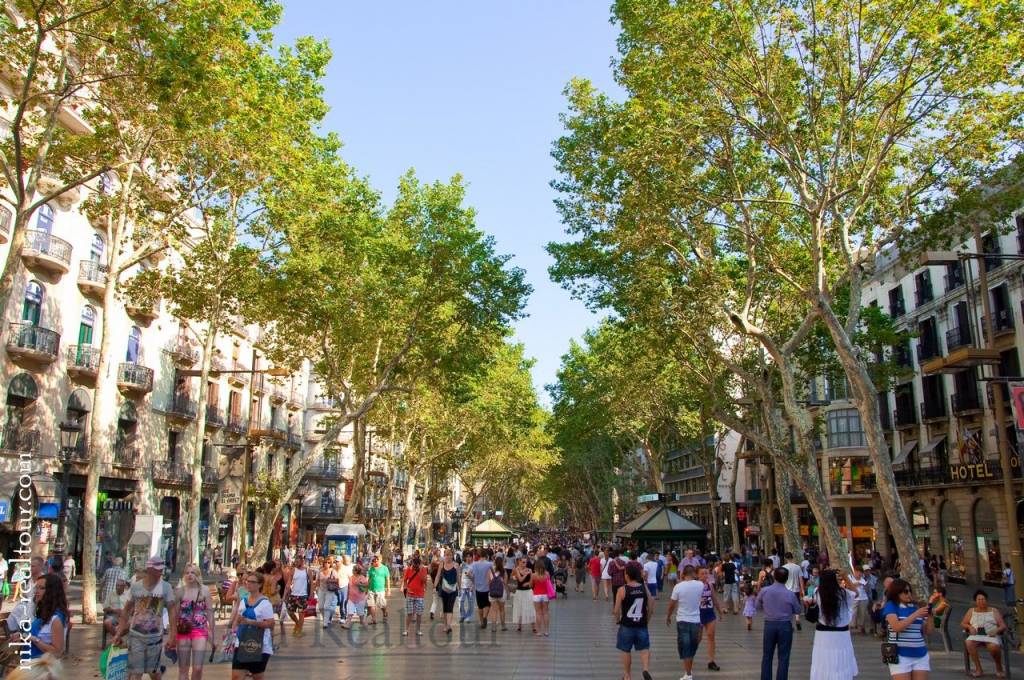
Las Ramblas now dissects the old city – leaving El Raval (also from Arabic meaning beyond the walls) to the left and El Gotico to the right. The name “Las Ramblas” is essentially plural – meaning many ramblas all collected together. Ramblas has even coined its own word “ramblear” meaning to stroll / ramble as many neighbors and visitors do on weekends.
From the city’s main square – Playa Catalunya – down to the Port and the monument of Christopher Columbus, Las Ramblas epitomizes Barcelona and is a colourful, 24-hour street where you can find a mix of neighbors and tourists alike.
The whole of the promenade is dotted with paper kiosks which are open twenty-four hours, and is the best place to get your hot-off-the-press copy of the local and international news.
Back in the day, Las Ramblas appeared to be a river bed that ran from the mountain tops to the sea.
The main areas of Las Ramblas
Although Las Ramblas is one steady street, it in fact is made up of 5 Ramblas:
– Rambla de Canaletes
– Rambla del Estudis
– Rambla del Sant Josep
– Rambla del Caputxins
– Rambla de Santa Monica
Rambla de Canaletes is the first Rambla starting at Plaza de Catalunya. This Rambla is named after a fountain. According to a legend, when you drink from the fountain, you’ll come back again to visit Barcelona. The second Rambla is Rambla del Estudis. It is named after a 16th century university, the Estudis Generals.
Starting from the top of Plaa Catalunya, and walking down to the port (slightly downhill) we have Rambla de Canaletes – named after the fountains at Plaa Catalunya. This part of Las Ramblas is a favourite for the local OAPs to collect and set the world to rights, as well as the typical hang out for the FC Barcelona fans after a victory (particularly if it’s over their bitter rivals Real Madrid).
Next in the continual transition is Rambla de los Estudios (studies), which joins the Catalana Library on Calle infirmary, and is where the beginning of the street performers and human statues Las Ramblas has become so famous for, start to appear.
Rambla de Sant Josep is named after the famous market of Saint Joseph, also more commonly known as “La Boqueria” – allegedly Europe’s biggest food market selling everything edible under the sun.
This stretch is closely followed by Rambla de los capuxinos, where you will find some of the city’s finest and oldest cafes sitting alongside the impressive Liceu Opera house and have been the inspiration to several visitors and writers to Barcelona. What better place to stop and write a postcar with a caf con leche than here!? This part is often referred to as rambla de les flores due to the many flower sellers crammed into the small space here. It’s also a dazzling place to visit during the saint George’s day celebrations (the patron saint of Catalunya) as roses are historically given on this day.
The following Rambla is Rambla del Sant Josep named after a convent which was demolished in the mid 1900 and replaced by Mercat de Boqueria. La Mercat de Boqueria is a common fruit market. Here you can find refreshing fish, vegetables, fruit and beef.
The fourth Rambla is Rambla del Caputxins. This Rambla is also named after a demolished building, Capuchin monasterysturdy. A fascinating building, called Gran Movie house del Liceu, is situated at this portion of Las Ramblas.
The final stretch is Rambla de Santa Monica, named after the old Portal de Santa Monica still untouched on a nearby street. Here the city’s many artists and caricature painters plant their stalls along with the everyday three cup conmen who never fail to attract interest. Crowning the base of Las Ramblas and the entrance to Port Vell (“the old Port”) is the Christopher Columbus monument – pointing out towards Las Americas. Look for fantastic and inexpensive Ferienwohnungen Barcelona next to the Columbus monument.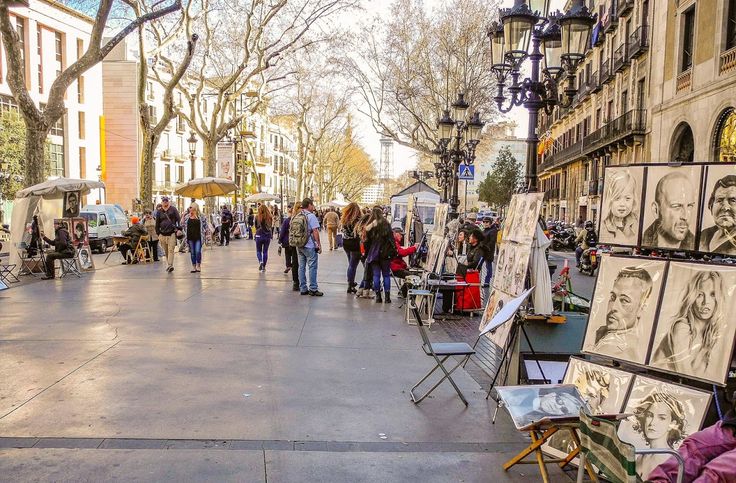
This Rambla leads to a roundabout with the Columbus Monument. This portion of The Rambla is broader then the higher Ramblas and while strolling down make sure to glance to your left and walk into Plaza True for a drink to cool off. If you want paintings from locals artists, you should find most here, and at the end of Las Ramblas, you’ll find a nice roundabout which has the statue of Colom as a middle point.
From Las Ramblas you can cross a bridge over the sea and carry on your explorations by going into the Maremagnum complex.
Check out our guide on where to stay in Barcelona for more info on staying in Las Ramblas and hotel options.
Looking for more tips on Barcelona? Check out these posts:
- Water Sports in Barcelona
- The Most Unusual Museums in Barcelona
- The Best Viewpoints in Barcelona
- Where to Get the Best Ice Cream in Barcelona
Author
- Travel Dudes
I’m sure you’ve had similar experiences I had whilst traveling.
You’re in a certain place and a fellow traveler, or a local, tip you off on a little-known beach, bar or accommodation. Great travel tips from other travelers or locals always add something special to our travels. That was the inspiration for Travel Dudes.
Barcelona, Spain
View Larger Map
Similar travel tips
Explorer Videos
More travel tips
Ramblas in Barcelona – what to see and what to visit
There are similar streets in any more or less large city. In Moscow, this is Arbat, in St. Petersburg – Malaya Sadovaya, but in Barcelona – Rambla or Ramblas. It is one of the local attractions of the city, which has taken the form of a multi-colored boulevard 1.2 km long. The beginning of the boulevard is the central square of the city, and the street ends near the monument to Columbus, which is located in the Old Port. This Spanish landmark resembles in essence one of the French boulevards, but due to its length it differs significantly from other famous boulevards.
The street is divided into 5 parts, each of which is full of life around the clock. Walking along the Ramblas, you can meet actors and musicians, enjoy street concerts and funny theatrical scenes. Naturally, it is here that you can buy a variety of souvenirs and other interesting things that are sold in shops and tents. And right there you can lose your wallet and other valuables, because the Rambla is a favorite place for pickpockets!
While in the first part of the Ramblas, called Canaletes, it is recommended to take a sip of water from the drinking fountain. According to popular beliefs, a person who has tasted the water from this source will certainly return to Barcelona again. Do not get carried away with the absorption of life-giving moisture, otherwise you will have to stay to live in this city!
Further, the second part of the Rambla Teachings boulevard, where the notorious university previously worked, welcomes tourists.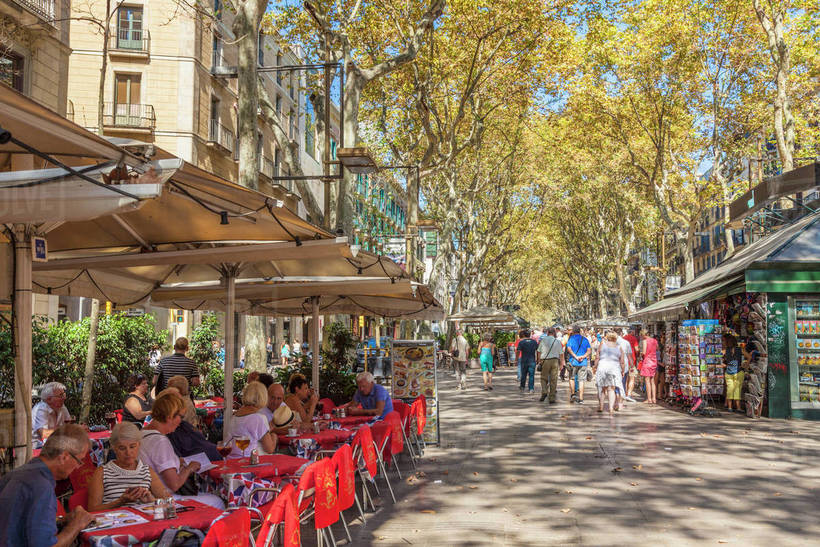
The third part of the Spanish attraction is called the Boulevard of Flowers. Here, not only beautiful flowers grow everywhere, but you can also buy them in numerous stalls that work 24 hours a day. The main building of this boulevard is the Virreina Palace, built in 1775 by order of the Viceroy of Peru, Manuel d’Amata. Now the castle houses the exhibition centers of Barcelona. Not to be missed is the Boulevard of Flowers and the Boqueria Market. This is the largest market in the city where you can buy absolutely everything. The Plaza del Os has preserved the work of the famous Spanish artist Joan Miro in the form of a mosaic.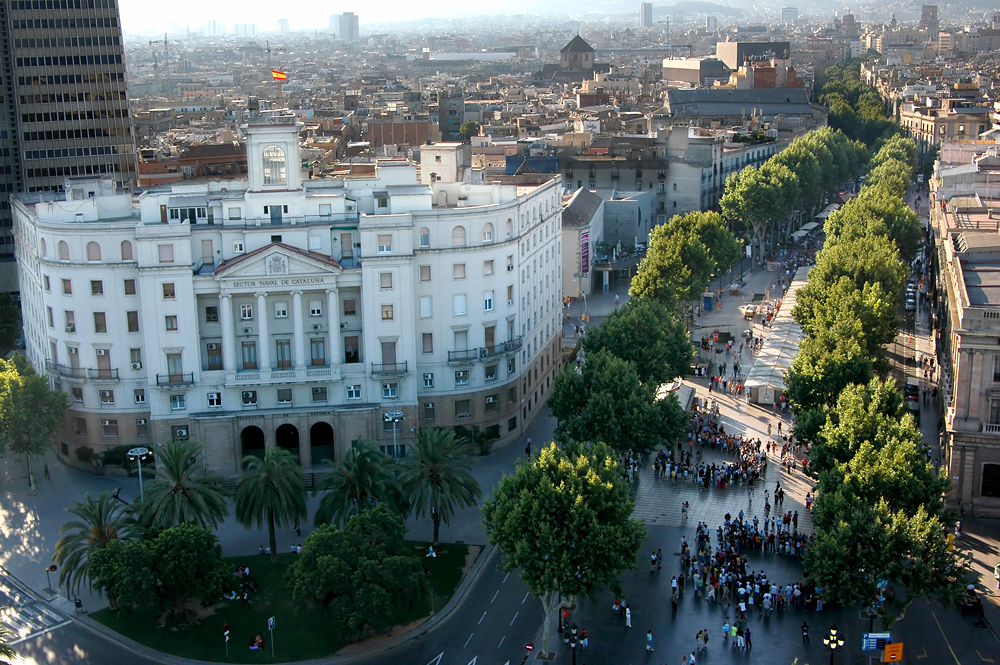
The fourth part of the Ramblas is opened by the Gran Teatro Liceu, which boasts one of the largest theater halls in the world. You can visit the theater accompanied by a guide from Monday to Sunday from 10:00 to 13:00. You can buy a ticket for the performance from 6.50 to 174 euros. Also on the boulevard is the Principal Theater – the first theater in Barcelona. The continuation of the boulevard is the Royal Square, the center of which is the very first work done by Gaudí, called street lights.
The fifth and final part of the Ramblas is the Rambla St. Monica. Being in this part of the city, you can admire the 80-meter-high Columbus monument and walk along the Portal de la Pau square.
How and how to get to the Ramblas
You can get to the beginning of the Boulevard via the Barcelona Metro. This Spanish landmark is served by three stations – Liceu, Catalunya and Drassanes. They all follow line 3. You can also use the services of city buses. Routes 14, 59 go to the Ramblas, 91.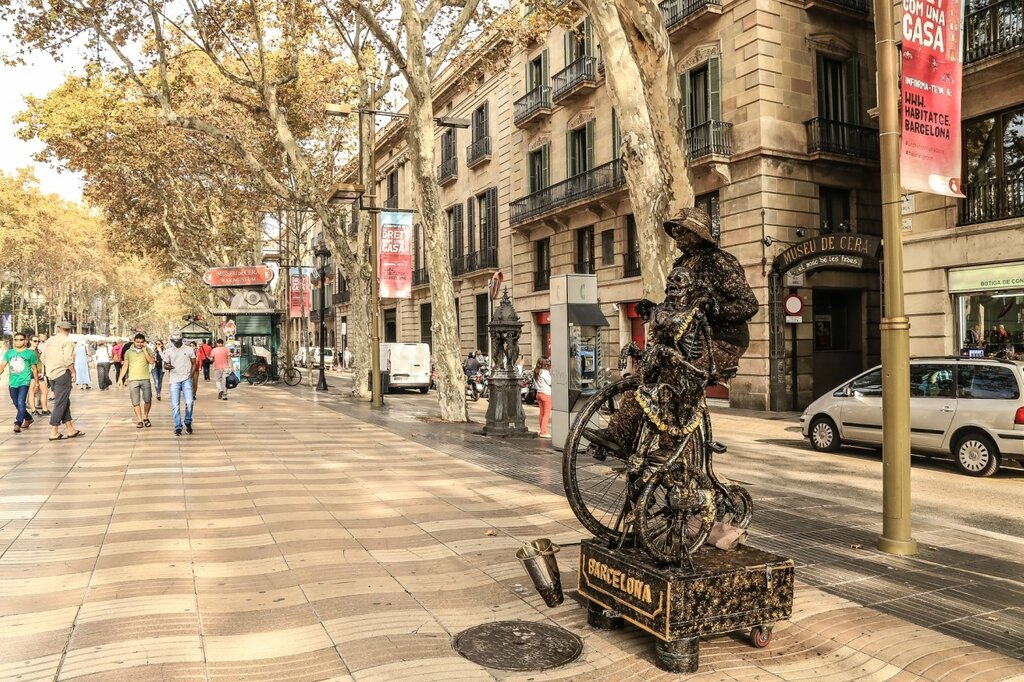
Once you reach Plaça Catalunya, before heading down the Ramblas, we advise you to visit El Corte Inglés shopping centre, where you will find a supermarket and inexpensive cafes where you can have a good lunch.
Las Ramblas. Site description
General information
Photos
All photos 181
Add photo
Location description
In the place where Las Ramblas now passes, a river once flowed. The name of the street is connected with this – in Arabic the word “rambla” means “dried riverbed”.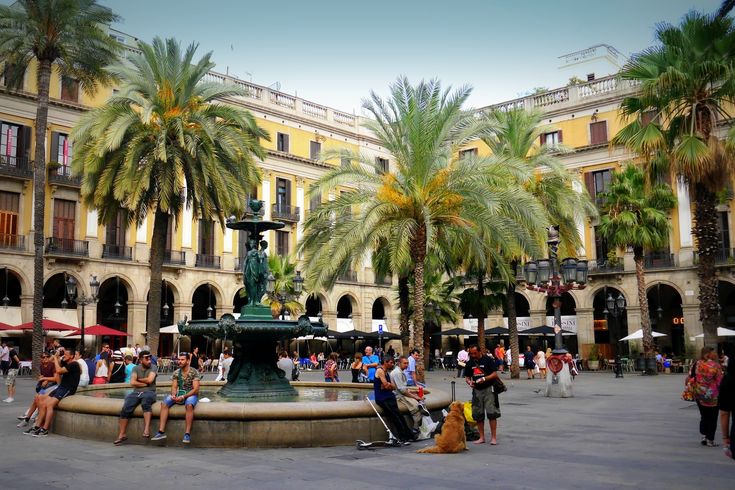
This is Barcelona’s most important pedestrian and tourist artery, with palaces, theatres, museums, churches, a market and numerous outdoor cafes. Life here is in full swing, never stopping for a moment. An integral part of Las Ramblas has become living statues that stand along the entire street to the monument to Christopher Columbus: these are animators depicting a dracula, a pharaoh, a mermaid, a butterfly, a cowboy, an angel and a demon, and even a man on the toilet. One has only to throw a coin, as the statue immediately comes to life.
Among tourists, Las Ramblas is very popular, second only to the famous Sagrada Familia
Guest ratings
Historical value
Good, 4.30
Cleanliness
Good, 4.23
Distance from the center
Good, 4.71
Infrastructure
9 0002 Good, 4.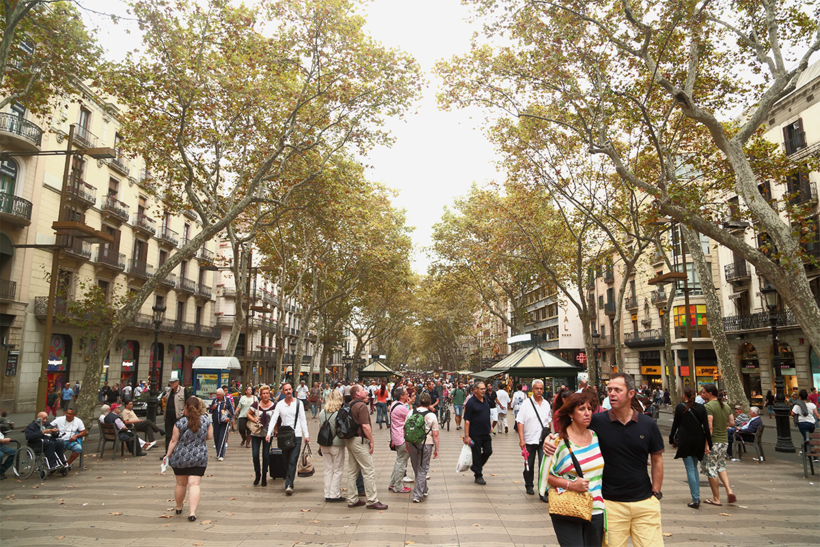
Criminal situation
Average, 3.80
Crowded
Bad, 2.53
All ratings – 52
Add rating
Tourists
Your friends have been here, see their reviews and ratings
all tourists 632
Similar places
0.00
Add to travel guide
Gaudí Lanterns
Spain, Catalonia, Barcelona
3.58
Add to guidebook
Sculpture “Ascension of Christ” in Barcelona
Spain, Catalonia, Barcelona, Montserrat
0.

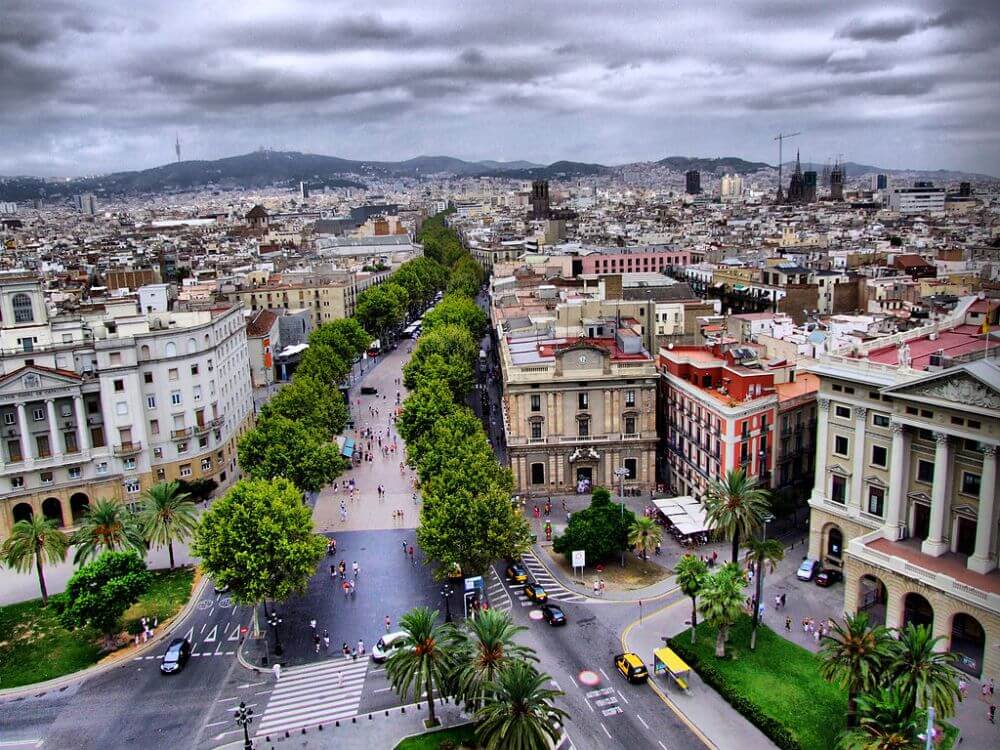 You’re in a certain place and a fellow traveler, or a local, tip you off on a little-known beach, bar or accommodation. Great travel tips from other travelers or locals always add something special to our travels. That was the inspiration for Travel Dudes.
You’re in a certain place and a fellow traveler, or a local, tip you off on a little-known beach, bar or accommodation. Great travel tips from other travelers or locals always add something special to our travels. That was the inspiration for Travel Dudes.